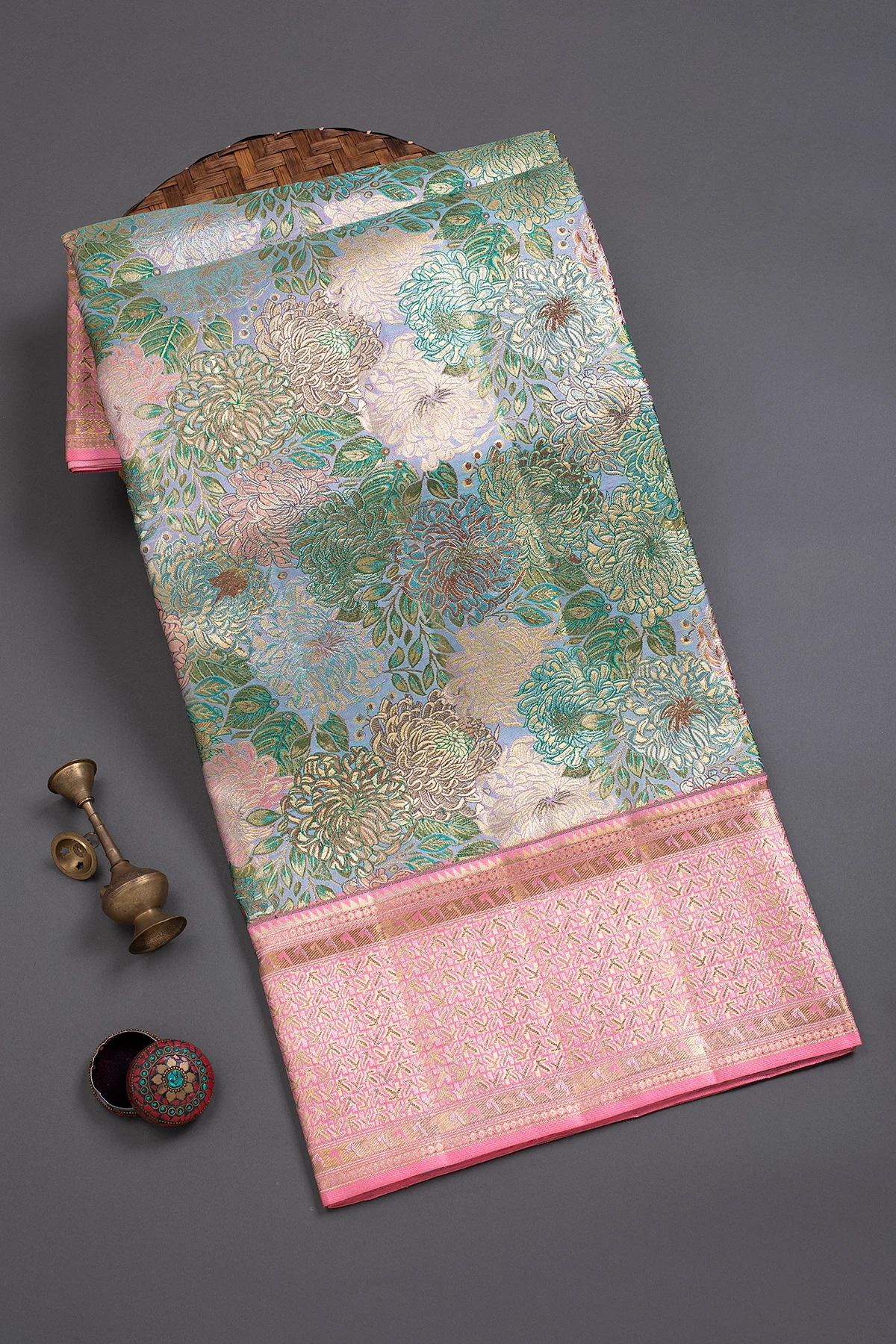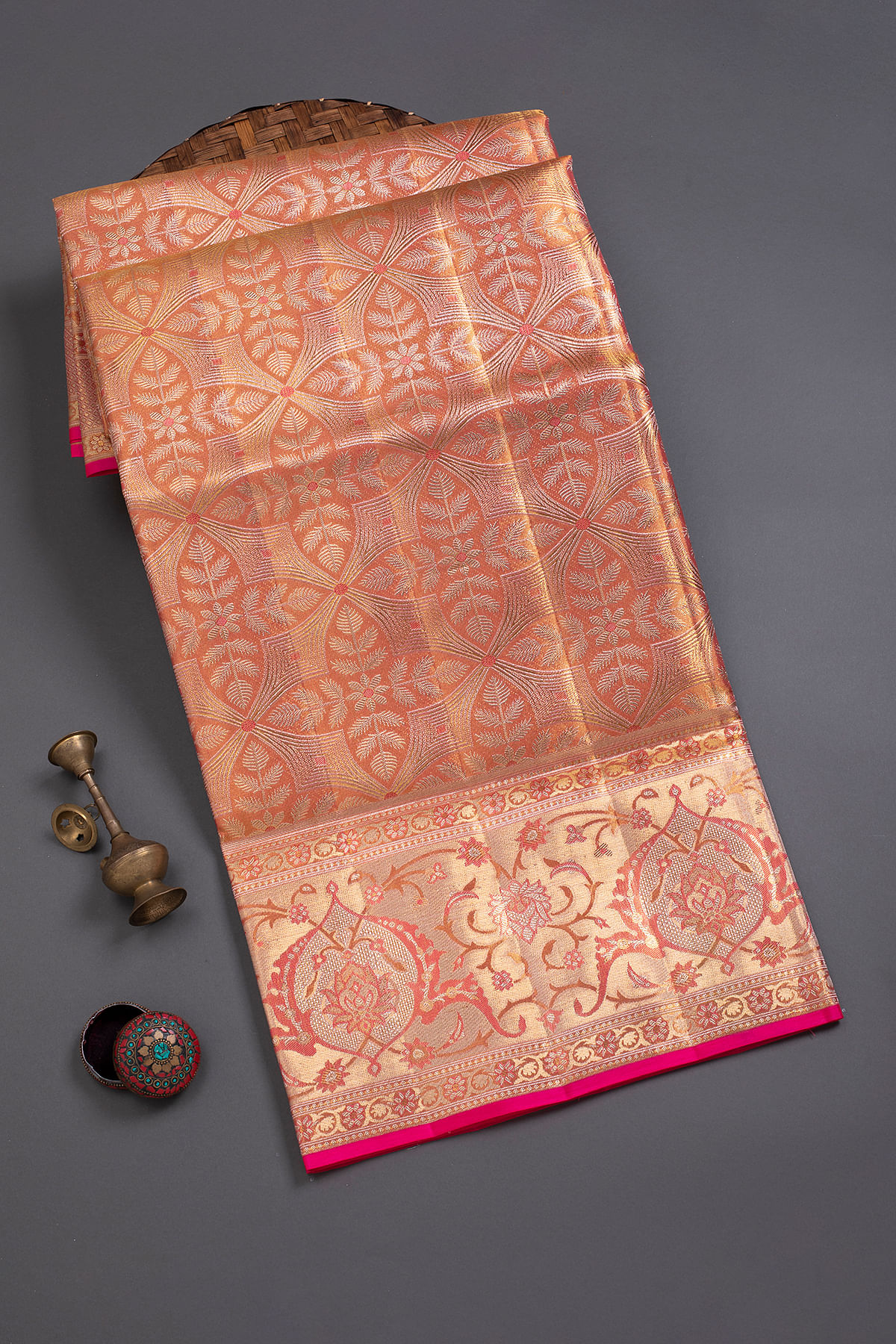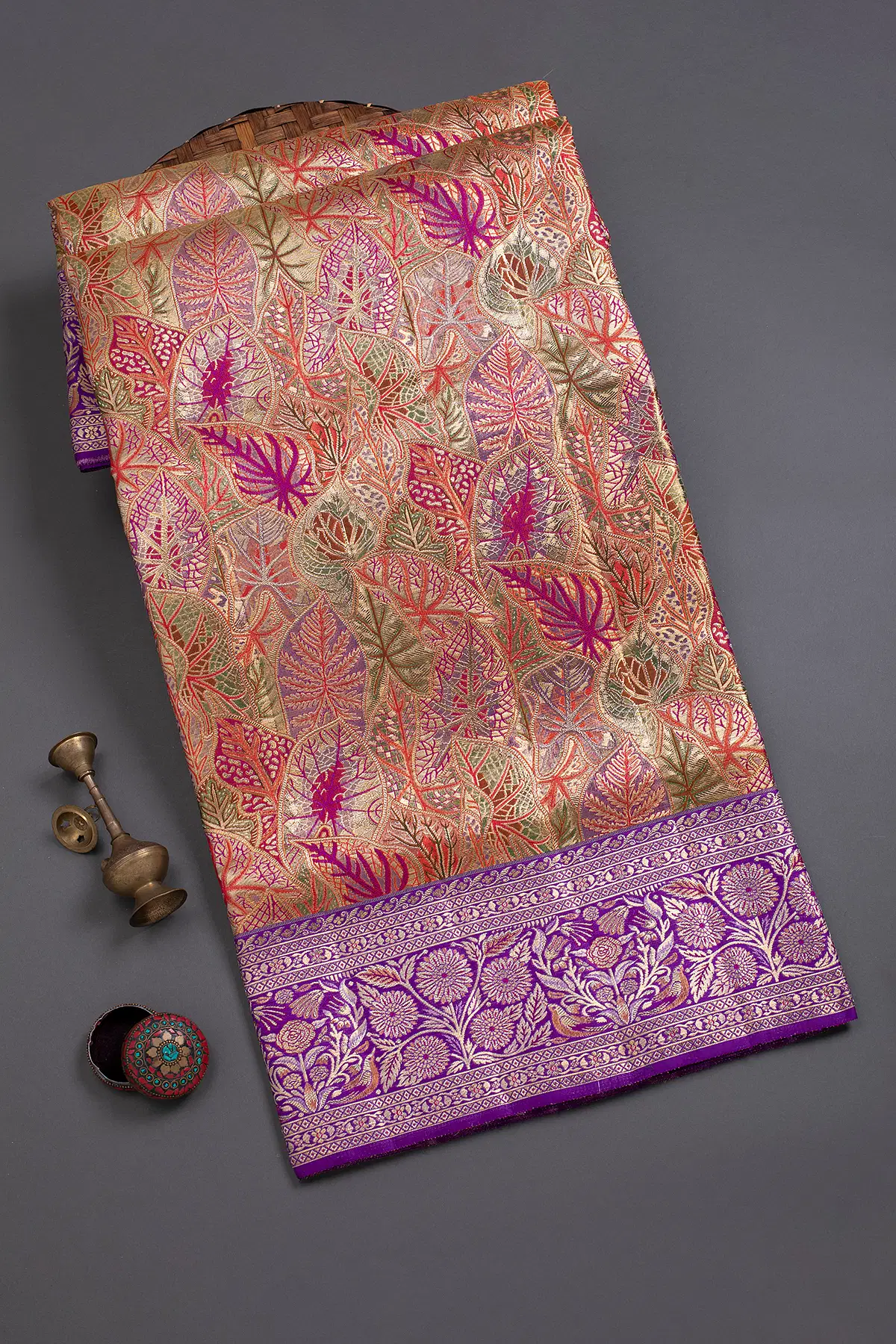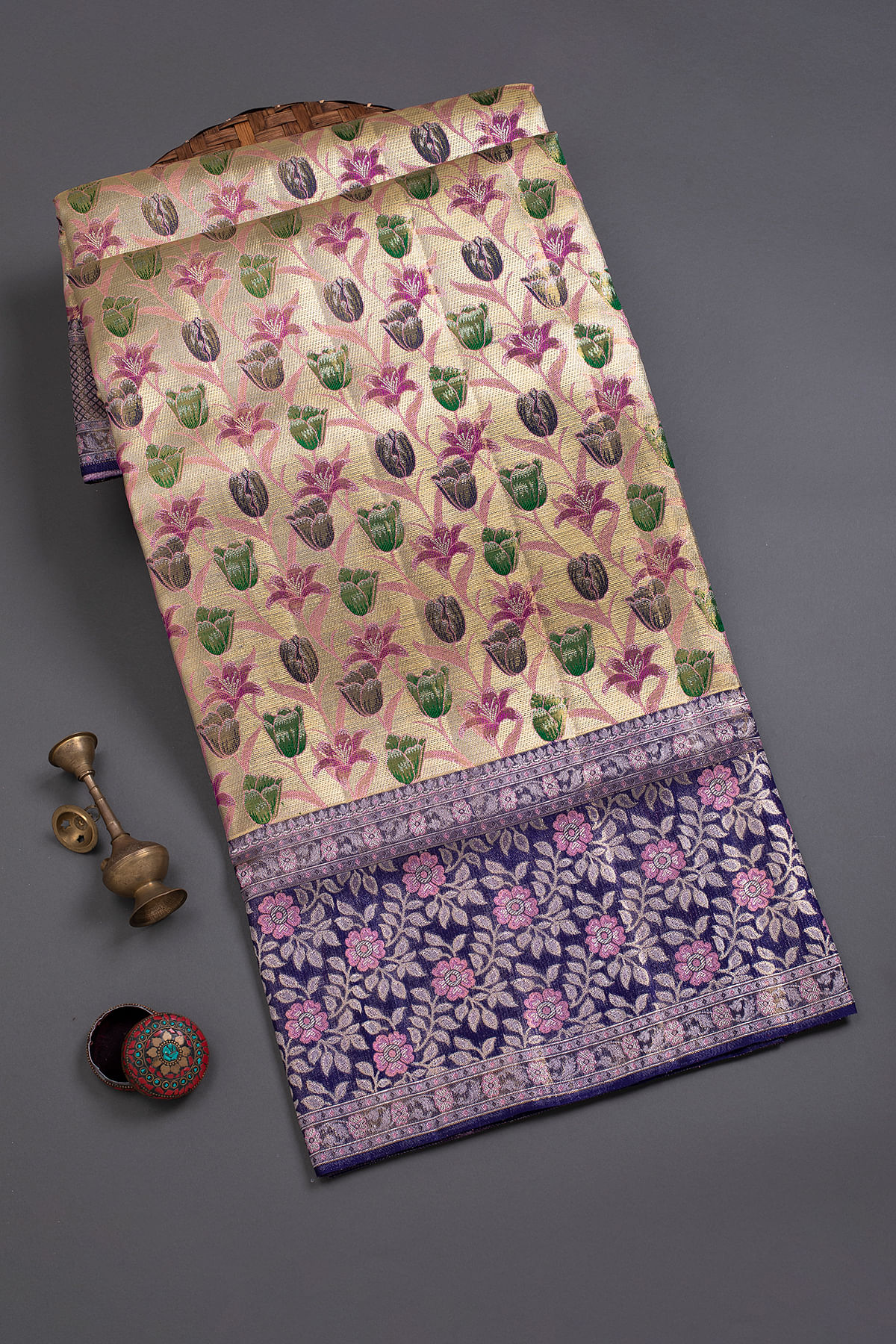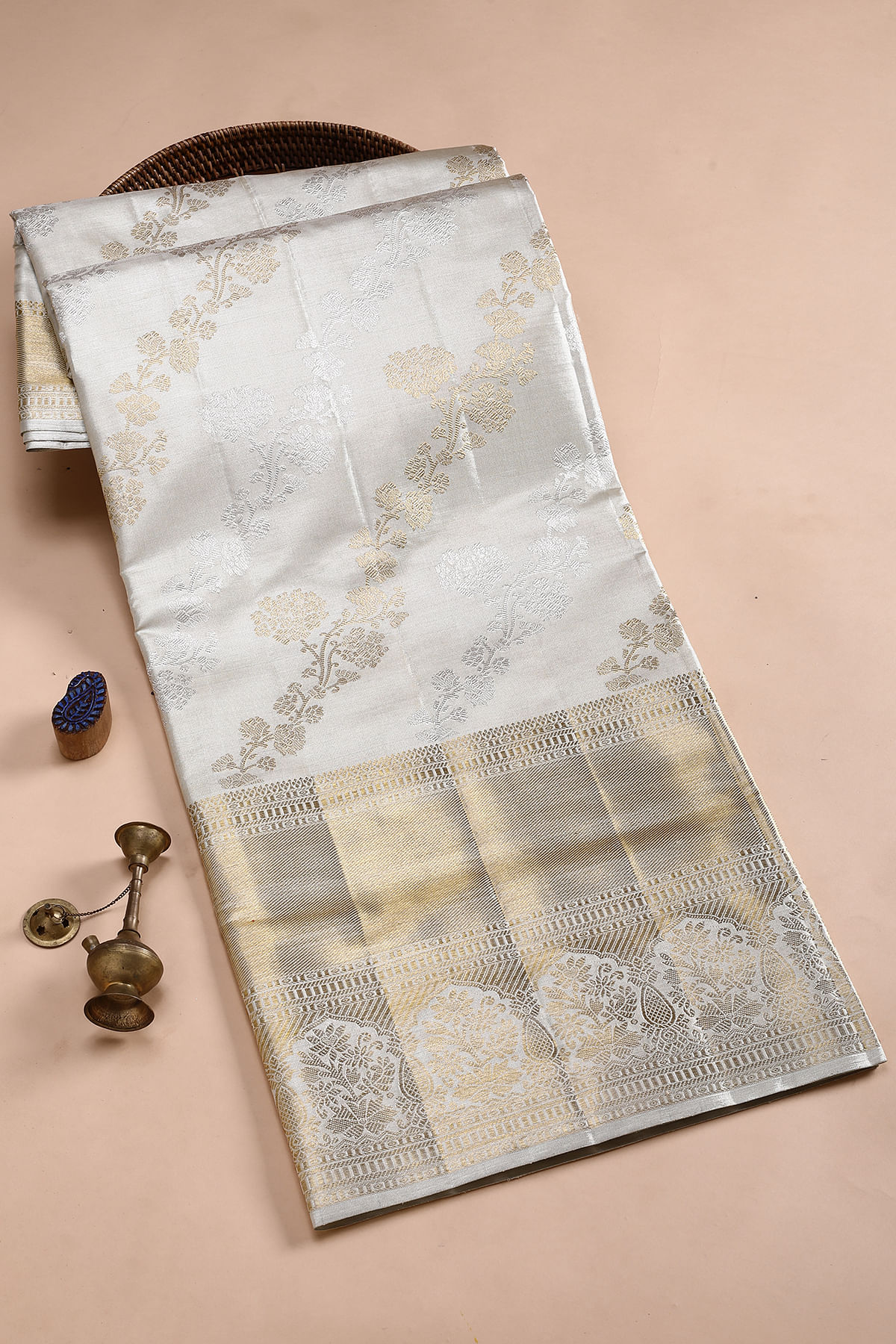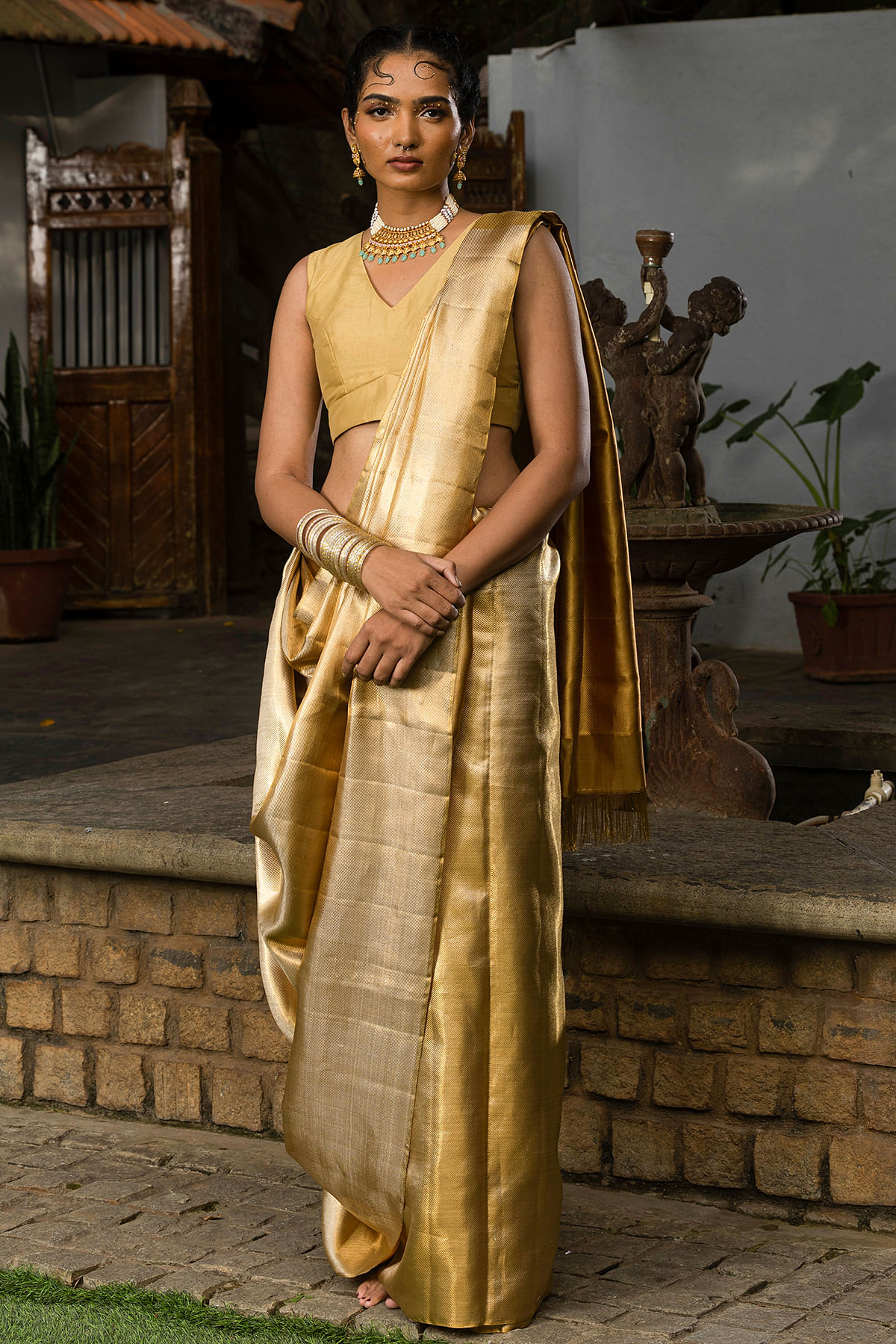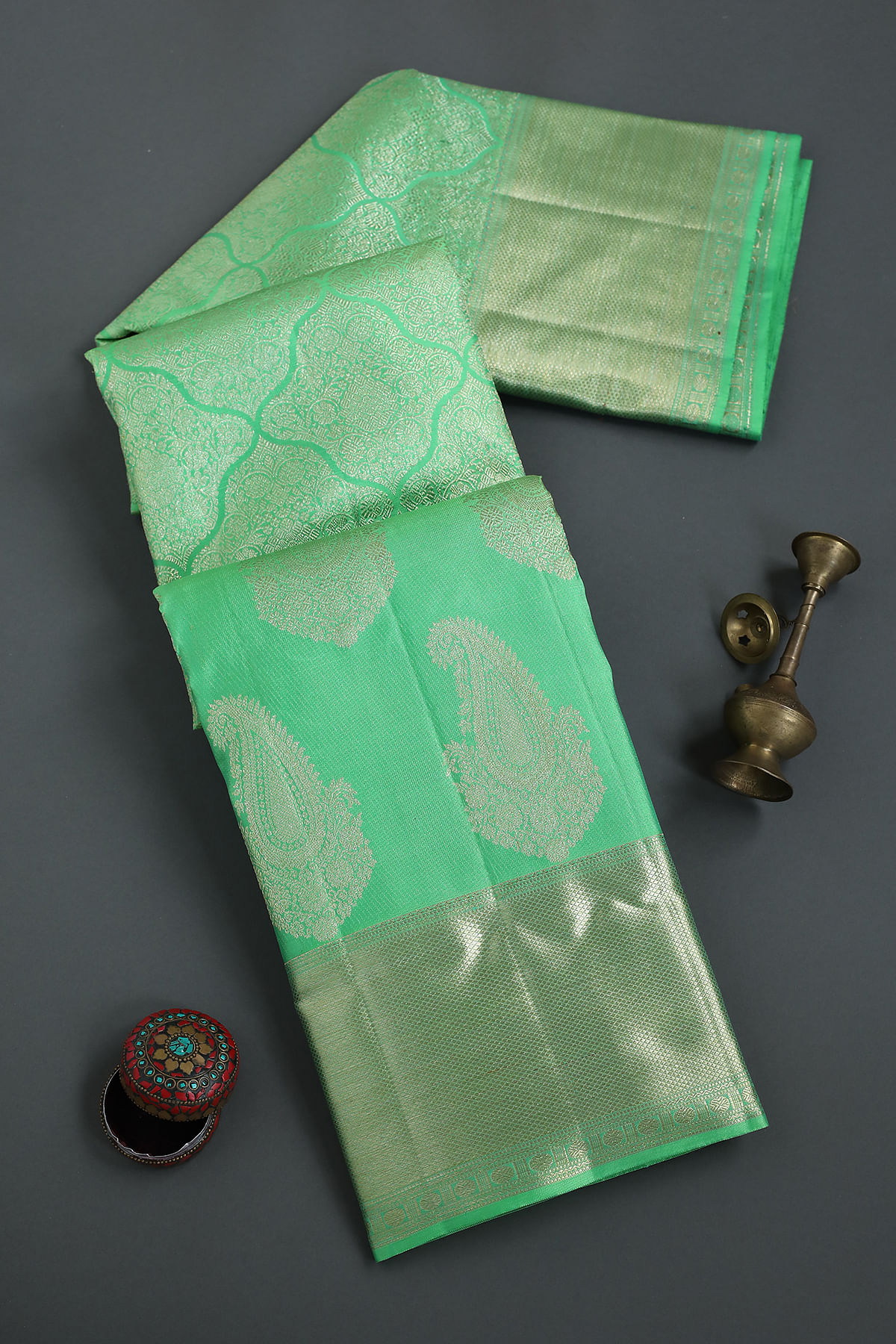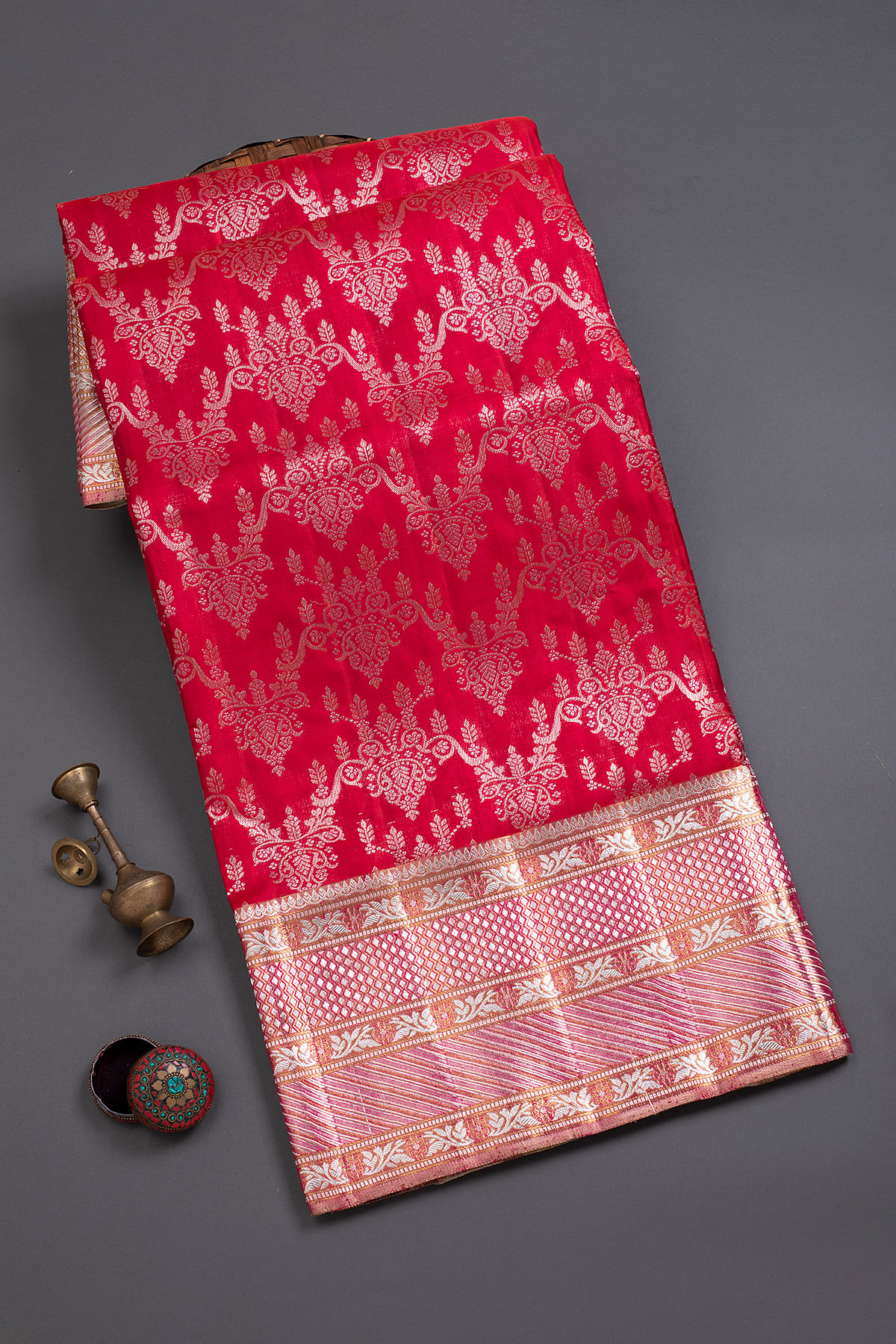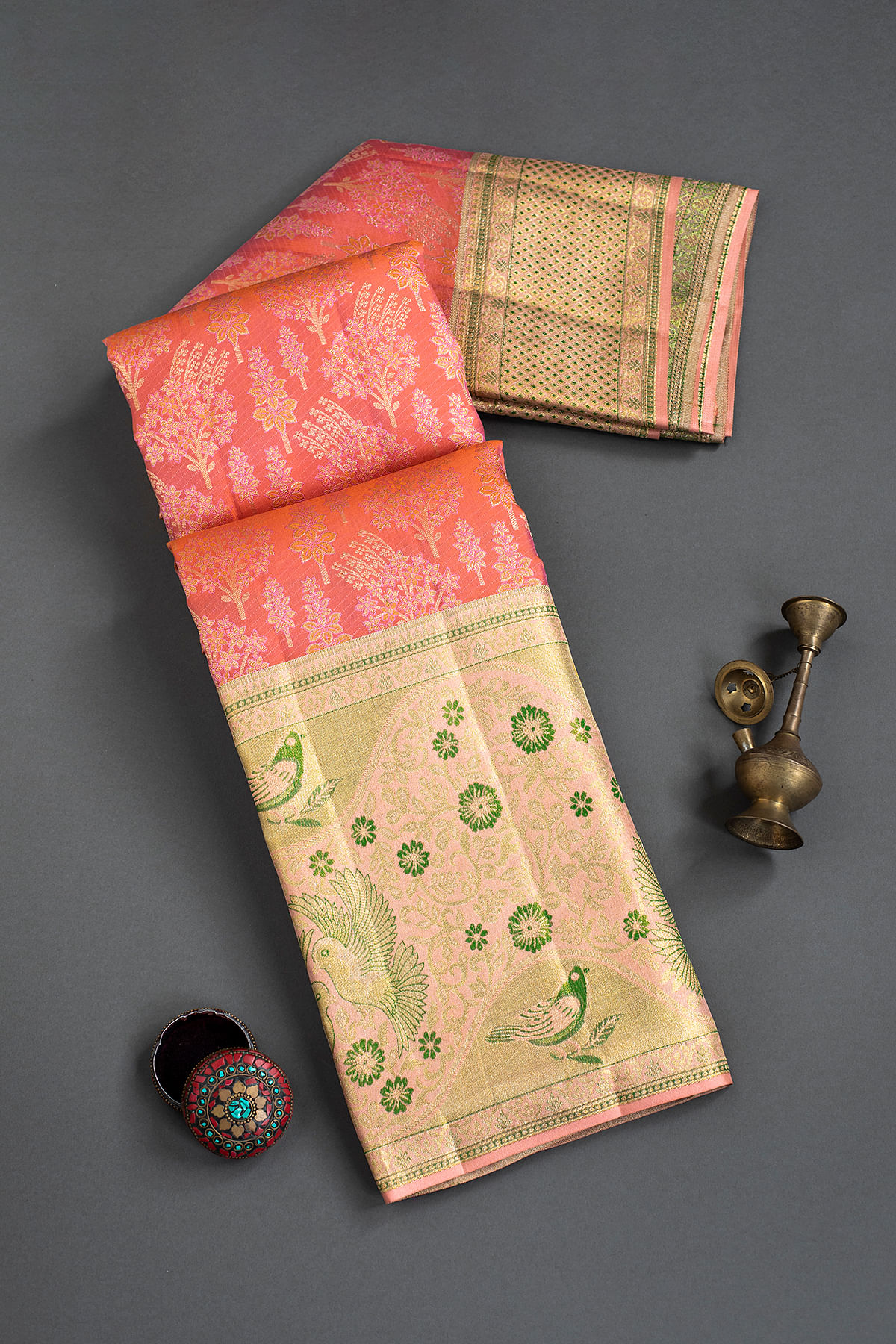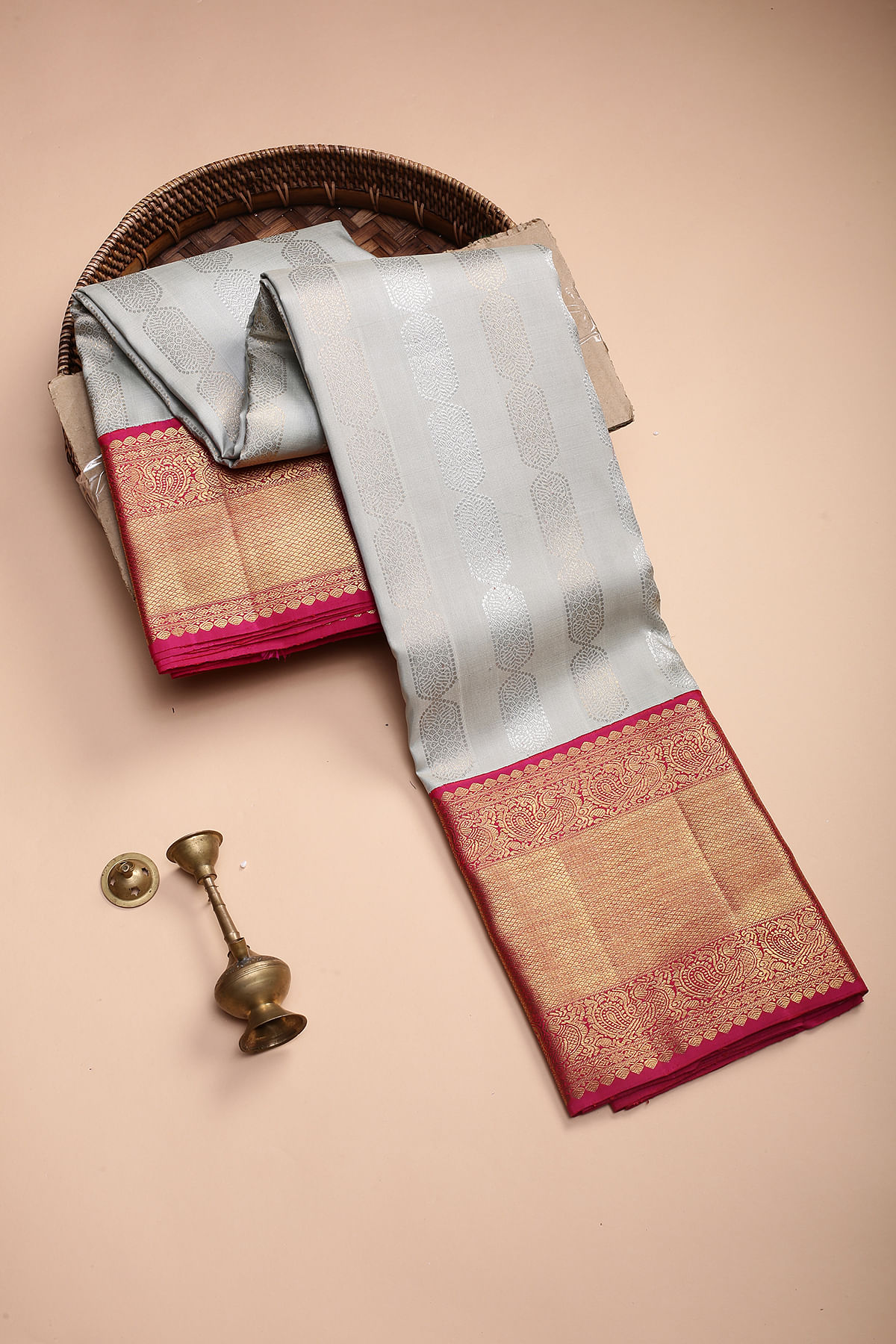A Kanchipuram Saree is not only an attire. It represents generations, the mark of excellent jobmanship and belongs in every conventional closet. Alternate terms used include Kanjivaram Saree or Kanjeevaram Saree and it is a union of centuries of cultural pride alongside the changing design sensibility. These sarees are etching a new definition of class in the modern Indian women as they are now available in soft silks, shimmering zari, stripping borders and superb designs of Kanchipuram blouses in sarees. Celebratory dresses, whether it is the wedding, festive or even the cultural dress, are created to make an impression.
These are the prettiest Kanchipuram saree outfits that make the best blend of fashion and culture.
1. Ashika Ranganath Glows in Beige Gold Charm
This beige and gold silk saree made in Kanchipuram is also a grace meeting grandeur as it adorns Ashika Ranganath. One sees the entire body is decorated with intricate zari woven patterns which eloquently tells about the craft touching the traditional silk sarees. The conventionality of the silk temple border makes the whole set look traditional, and the pink and golden woven pallu gives the outfit the element of contrast and celebration. The dark pink and gold silk blouse is made even without sewing the threads, and this blouse is simple-cut, which balances the richness of the saree without disturbing the purity of this drab dress. It presents a blank paper to draw any beautiful Kanchipuram blouse designs. Great as a wedding look or a cultural gathering, this look has a soft elegance and royal prettiness.
2. Off White Gold Blossom Kanchipuram Touch
The saree is made of Kanchipuram tissue silk with off-white and gold two-tone color combination which is divine in elegance. The pure zari work that covers the body is so finely done that it makes the body exude a rich texture and the red and gold silk border makes it boldly festive in appearance. The detailing of the border is repeated in the matching pallu which makes the drape harmonious. When coupled up with an apple red silk blouse that has the golden zari border, the look becomes even radiant. This saree is ideal to be worn during mass rituals, wedding ceremonies, and any other person intending to exude high culture traditionalism.
3. Dusty Pink Dream Kanchipuram Magic
Very soft and beautiful this dusty pink Kanchiphuram silk saree is an ethereal one to wear by women who love understated beauty. The saree is adorned with exquisite floral patterns using intricate zari works and has a dual-color gold and British racing green korvai border or correlating pallu. The unstitched blouse in an elegant British racing green and black two-tone also goes well since it blends with personalized Kanchipuram blouse designs. This set is best suited in celebrating a festive night, family gathering or engagement party.
4. Green Grace with Bold Contrast Vibe
Rich in colour and crafted with unparalleled care this Sacramento Green Kanchipuram silk saree gives a newness to traditional. The fine 4-gram zari work embroided intricately all over saree will give a subtle shine & texture. It is partially elegantly painted with korvai border and pallu in sober salt colour Rosebloom pink setting beautiful accent with bold ever elegant appearance. The unstitched silk blouse of the same Rosebloom pink color adorns the look entirely, and gives space for trend much kanchipuram blouse designs that fit on to your manner.
5. Royal Purple Spark with Silk Statement
Flamboyant and classy, this is a royal purple silk saree- it catches the eye with the traditional zari work all over the silk. The saree has 2 grams of zari woven on its surface and this makes it sparkle in the right amount to make it look royal but not too much to be overpowering. The piece of the blouse that is not stitched offers a very good option since it can be tailored specifically to fit in during evenings receptions or temple events. When wearing this gorgeous Kanjivaram saree, don traditional jewellery in gold with a neat bun so that this style appears classy and regal.
6. Silver Gold Glam with Tissue Twist
Make the modern update to your wardrobe with this silver gold Kanchipuram tissue saree. This beautiful piece is decorated with the intricate zari woven designs of so-called 2 grams gold and German silver, which makes the work exquisite with an extra glow and two tinary character. Being made of a lightweight fabric, it does not take much effort to carry it, and a blouse made of unstitched silk in a matching color also contributes to a seamless effect. This saree would be ideal at any wedding ceremony or at prestigious get together functions due to its ability to combine the magic of tradition with the grace of the present day.
7. Golden Glow Woven with Timeless Grace
A picture worth a thousand words, this is a gold kanchipuram tissue saree that is a marvel to the eye. The zari woven intricate work flows all the length of the saree thus making it shine or glowing wherever it moves. The tissue edge and contrasting pallu are adding the class thus stand out as one of the best in special events. The zari blouse can be tailored in unstitched tissue blouse of the same golden tone, and endless possibilities of blouse designs are available with the same at Kanchipuram. The pure zari and German silver weaving put together make a saree which is a timelesskeepsake.
8. Classic Gold Drape with Silk Shine
When you want a saree that spells out elegance in opulence, then this gold Kanchipuram tissue silk saree suits the description. The all over zari work leads to a sheeny effect, whereas the design of self zari and pallu do not allow the saree to look too flashy. This is a part of a set and comes with a separate uncut piece of blouse so that you can add your own embellishments to it with whatever kind of embroidery or sleeve or neckline design that you prefer. The blouse shown in the picture is a visual reference to the Afghan designer of the model, and you can create your spin on this iconic garment with a particular sense of your own.
9. Silver Shine Pure Tissue Beauty
This is an Indian silver Kanchipuram tissue saree that needs to be on the wish list of a prettiness lover. With a light silver hue, the saree is expertly woven with silver zari which brings incredible elegance. It is lightweight yet rich in look and is ideal to be worn at weddings and receptions or some formal evening events. The saree takes its complement with a matching piece of unstitched blouse that leaves space to accommodate a beautiful blouse of Kanchipuram design that goes with your occasion and preferences.
10. Golden Gleam with Luxurious Texture
A regal hue of gold was achieved through dyeing this pure Kanchipuram silk saree which is made of tissue silk. This beautiful drape features artistic zari woven designs all over the body of the piece, the border and the large pallu that makes it look so majestic. The material of unstitched blouse in the silk will provide the finishing touch to your traditional outfit and also gives you the flowing to play with the latest or classical kinds of blouse outfits. Style it with a statement polki set and an embroidered clutch to make a statement look this festival season.
Last Words of Eternal Grace
A Kanchipuram Saree is more of a feeling than a garment. To the detailed zari edges with the opulence of the pallu, there is a story behind every saree to take you back to the origin and at the same time be stunning in your own way. Such sarees are trendless, have a wide usability, and carry a deep meaning. When accompanied with aptly designed Kanchipuram blouses, then the outcome will be a perfect ethnic look that is full of culture and modernity.
When you are willing to go luxurious yet classic, unravel an array of such classics only to discover more at Samyakk which is your ultimate source of high value sarees that makes you feel special.





















